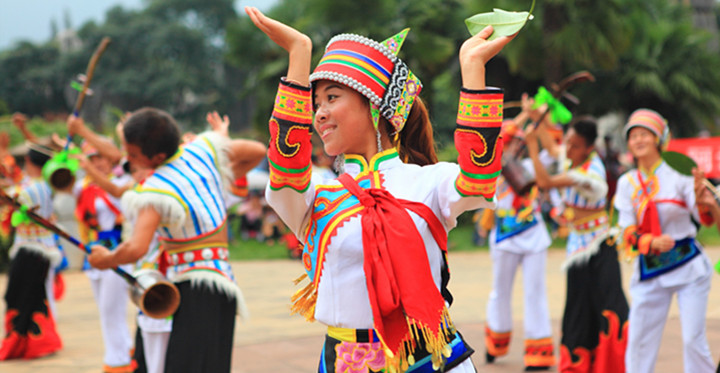

There are Sani People in Shilin County. As a branch of Yi, they are mainly distributed in Shilin County, Luxi County, Mile County, Qiubei County, Yiliang County and Luliang County.Sani People call themselves “Ni”, meaning happy people. They are diligent, brave and good at singing and dancing. Sani People have deep feeling for almost every hill and stone. There is a touching story concerning every scenic spot and the most popular is The Story of Ashima.
As a branch of Yi, Sani People enjoy some common cultural features such as similar character, religion and customs with the other branches of Yi. But they have their own features in religion, costumes and buildings.Yi People boast a long history. Their ancestors admired tigers and regarded tigers as their totem. But besides tigers, the totems of Sani also include spiders.
Location
The Sani people live in central and eastern Yunnan province in southern China. Around 80,000 of the Sani live in Shilin county near the famous Stone Forest. There are approximately 200 Sani villiages in Shilin county. Lunan, the capital of Shilin county, serves as a hub for many Sani and hosts two market days each week. The rest of the Sani people live in nearby Mile, Yiliang, Qiubei, and Luxi counties. The dark red region on this map shows the approximate area where the Sani live.


Language
The Sani language is part of the Tibeto-Burman language tree (1). Mandarin is also used as a trade language and in the government run schools. Only the Sani spirit priests are able to read the Sani written language, which hinders efforts to put the scriptures into the Sani language.
Minority Status
The Sani are officially part of the Yi minority, one of the 56 official minorities designated by the Chinese government. There are 8 million Yi in 110 distict people groups living in Southwest China. The Sani have their own unique customs, language, and ethnic identity that differentiate them from other Yi people groups.
Ashima: Sani Legend
According to Sani legend, there once was a beautiful girl named Ashima, which means “as precious and bright as gold.” An evil landlord kidnapped her and forced her to marry him. Her lover (or brother, depending on the storyteller) Ahei came and rescued her, fighting bravely against the landlord. But on the way home, Ashima was killed in a flood. Today she is seen as the protector of the Sani people, as well as a symbol of hope and freedom to choose who to marry.
Lifestyle:
Most Sani people live in small, rural villages. The men grow crops like rice and wheat, and raise animals. The Sani women work in the homes, and are famous for their beautiful embroidery.
Religion
The Sani worship numerous spirits, including earth, fire, water, sky, mountains, stones, etc. The spirit of the tiger is believed to provide protection, and most Sani homes have a stone tiger above their doorway. The Sani also worship their ancestors. Each Sani village has a spirit priest who performs religious rituals.
Christianity
Very few Sani have heard the name of Jesus. A catholic missionary began working among the Sani in 1887 (1). He drew converts by opening a school for Sani catholics. The Sani were not allowed in Chinese schools at that time. Today the remnant of Sani catholicism is heavily mixed with traditional Sani beliefs. Today there are 25 known Sani believers.
The Stone Forest
The Stone Forest is a massive “forest” of limestone formations in Shilin county, where a majority of the Sani live. These rocks are up to 98 feet high. Sani legend says that the gods smashed a mountain so that young lovers could find privacy. The Stone Forest is also on the World Heritage List of the United Nations Educational, Scientific, and Cultural Organization and is a popular tourist destination inside of China.
You will only receive emails that you permitted upon submission and your email address will never be shared with any third parties without your express permission.
